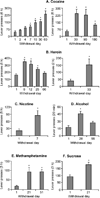Neurobiology of the incubation of drug craving
- PMID: 21764143
- PMCID: PMC3152666
- DOI: 10.1016/j.tins.2011.06.001
Neurobiology of the incubation of drug craving
Abstract
It was suggested in 1986 that cue-induced drug craving in cocaine addicts progressively increases over the first several weeks of abstinence and remains high for extended periods. During the past decade, investigators have identified an analogous incubation phenomenon in rodents, in which time-dependent increases in cue-induced drug seeking are observed after withdrawal from intravenous cocaine self-administration. Such an incubation of drug craving is not specific to cocaine, as similar findings have been observed after self-administration of heroin, nicotine, methamphetamine and alcohol in rats. In this review, we discuss recent results that have identified important brain regions involved in the incubation of drug craving, as well as evidence for the underlying cellular mechanisms. Understanding the neurobiology of the incubation of drug craving in rodents is likely to have significant implications for furthering understanding of brain mechanisms and circuits that underlie craving and relapse in human addicts.
Published by Elsevier Ltd.
Figures




References
-
- Hunt WA, et al. Relapse rates in addiciton programs. J. Clin. Psychol. 1971;27:455–456. - PubMed
-
- O'Brien CP, et al. Classical conditioning in drug dependent humans. Ann. N. Y. Acad. Sci. 1992;654:400–415. - PubMed
-
- Gawin FH, Kleber HD. Abstinence symptomatology and psychiatric diagnosis in cocaine abusers. Clinical observations. Arch. Gen. Psychiatry. 1986;43:107–113. - PubMed
Publication types
MeSH terms
Substances
Grants and funding
LinkOut - more resources
Full Text Sources
Other Literature Sources
Miscellaneous

